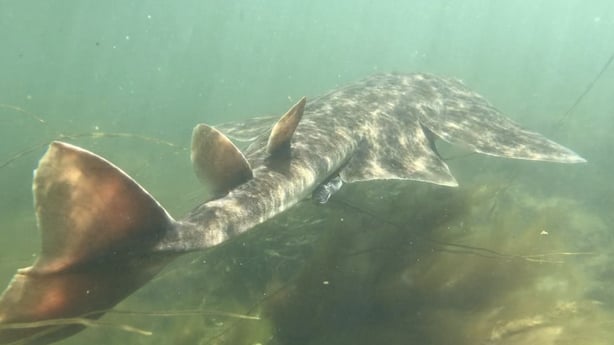Scientists in Galway have described a sighting of a rare shark off the west coast of Ireland as hugely significant.
Video footage of an angel shark was recorded by a team of kayakers at Galway Bay Sailing Club, near Rinville, yesterday evening, when a number of teenagers were having their regular lesson with instructor Colin O'Loan and one of his colleagues.
The group were in shallow water when the critically endangered angel shark swam among them.
"The kids were doing some snorkelling after taking part in a kayak camp," explained Mr O'Loan.
"The angel shark just wandered in amongst us. It was a real case of being in the right place at the right time - a million-to-one shot."
Maurice Clarke of the Marine Institute said the images were among the clearest ever filmed of the endangered species.

Scientists at the institute confirmed it was a mature angel shark.
The species thrives in shallow waters in sandy bays.
But while they were once common along the west and south west coasts, sightings have become increasingly rare in recent decades, to the point that they are now considered critically endangered.
Mr Clarke said the footage showed the important role 'citizen scientists’ could play in identifying and recording the vast marine life of Galway Bay.
Mr O’Loan, who recorded the footage on his mobile phone, said: "You just think you’re seeing a big fish underwater but we weren’t expecting to see that kind of wildlife in there.
"We thought it was a ray at the start and just when we got home, I did a bit of research and got confirmation from a few sources that we’d seen a fairly unusual, critically endangered angel shark."
He said the environment in which the sighting happened had shallow, crystal clear water, allowing the group to stand beside the shark and just watch it.
Mr O’Loan said the shark was swimming against the flow of the current, something he described as being like "an aquatic treadmill".
He estimated it was around 1.4 metres long and around 75 cm wide.
The finding occurred just a few hundred metres away from the Marine Institute headquarters.
Mr Clarke, who specialises in the human impact on shark populations, says despite years of research into the species, this is the first time that such evidence has been unearthed.
He said it was "one of the rarest fish in the north east Atlantic" with very few records of it in the last 20 years.
"The angel shark is critically endangered, it is now confined to only two or three places, one of which is Galway Bay, which is kind of like a refuge for the species," Mr Clarke said.
In the aftermath of this important sighting, marine experts are appealing to those enjoying the coastline to keep their eyes peeled for further evidence of this rare and precious species.
"It’s so rare… I think this is really unique footage that’s as good as has ever been seen of the angel shark," he said.
Mr Clarke is hopeful that the discovery may signify that there is a breeding ground close by.
"This is really, really fantastic news… this proof the angel shark still exists in the area… they look like a ray but they give birth to live young," he said.
"This may be a pupping ground for angel sharks. They can give birth to maybe 20 - 30 pups at a maximum, after a gestation period of a year, so this is a very strange species.
"With a reproduction rate like that, it takes a long time for the population to grow again".
And with many people expected to take to the water over the coming days, there is no need for beaches to be closed, or bigger boats to be got, due to the presence of the angel shark so close to shore.
"It’s got a big wide mouth and plenty of teeth so I wouldn’t go messing with them but, certainly, I wouldn’t be worried about them at all," Mr Clarke said.
"We can all be quite certain that we are under very little threat from this species. I would just be delighted that they’re still here."
Threatened
The angel shark, locally often called monkfish, rank as the second most threatened family of elasmobranchs (sharks, skates and rays) in the world.
It is a species of flat shark which poses no danger to humans and lives on the seabed buried in the sand.
It can reach lengths of up to 2.4 metres (females) and 1.8 metres (males).
Once common in areas like Tralee Bay, its numbers have fallen dramatically, largely due to its bottom dwelling lifestyle which makes it vulnerable to bottom fisheries.
The inshore waters of the Canary Islands are thought to be the species' last stronghold.
Earlier this year, a project was launched in Ireland aiming to help safeguard the species for generations to come.
Louise Overy, from Angel Shark Project: Ireland, said: "This is just amazing and shows that all hope is not lost.
"We would love to see such sightings become the new normal. Since we launched the project we have been chatting to a lot of fishers who tell us they would love to see the angel shark come back again."
With additional reporting by Philip Bromwell






